Related Research Articles

Merlin is a mythical figure prominently featured in the legend of King Arthur and best known as a magician, with several other main roles. The familiar depiction of Merlin, based on an amalgamation of historic and legendary figures, was introduced by the 12th-century British pseudo-historical author Geoffrey of Monmouth and then built on by the French poet Robert de Boron and their prose successors in the 13th century.

Saracen was a term used in the early centuries, both in Greek and Latin writings, to refer to the people who lived in and near what was designated by the Romans as Arabia Petraea and Arabia Deserta. The term's meaning evolved during its history of usage. During the Early Middle Ages, the term came to be associated with the tribes of Arabia.

The Song of Roland is an 11th-century chanson de geste based on the Frankish military leader Roland at the Battle of Roncevaux Pass in AD 778, during the reign of the Carolingian king Charlemagne. It is the oldest surviving major work of French literature. It exists in various manuscript versions, which testify to its enormous and enduring popularity in Medieval and Renaissance literature from the 12th to 16th centuries.

Sir Orfeo is an anonymous Middle English Breton lai dating from the late 13th or early 14th century. It retells the story of Orpheus as a king who rescues his wife from the fairy king. The folk song Orfeo is based on this poem.
Floris and Blancheflour is the name of a popular romantic story that was told in the Middle Ages in many different vernacular languages and versions. It first appears in Europe around 1160 in "aristocratic" French. Roughly between the period 1200 and 1350 it was one of the most popular of all the romantic plots.

Elaine of Astolat, also known as Elayne of Ascolat and other variants of the name, is a figure in Arthurian legend. She is a lady from the castle of Astolat who dies of her unrequited love for Sir Lancelot. Well-known versions of her story appear in Sir Thomas Malory's 1485 book Le Morte d'Arthur, Alfred, Lord Tennyson's mid-19th-century Idylls of the King, and Tennyson's poem "The Lady of Shalott". She should not be confused with Elaine of Corbenic, the mother of Galahad by Lancelot.
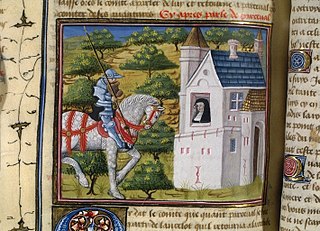
Perceval, the Story of the Grail is the unfinished fifth verse romance by Chrétien de Troyes, written by him in Old French in the late 12th century. Later authors added 54,000 more lines to the original 9,000 in what are known collectively as the Four Continuations, as well as other related texts. Perceval is the earliest recorded account of what was to become the Quest for the Holy Grail but describes only a golden grail in the central scene, does not call it "holy" and treats a lance, appearing at the same time, as equally significant. Besides the eponymous tale of the grail and the young knight Perceval, the poem and its continuations also tell of the adventures of Gawain and some other knights of King Arthur.
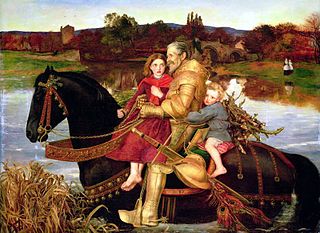
Sir Isumbras is a medieval metrical romance written in Middle English and found in no fewer than nine manuscripts dating to the fifteenth century. This popular romance must have been circulating in England before 1320, because William of Nassyngton, in his work Speculum Vitae, which dates from this time, mentions feats of arms and other 'vanities', such as those found in stories of Sir Guy of Warwick, Bevis of Hampton, Octavian and Sir Isumbras. Unlike the other three stories, the Middle English Sir Isumbras is not a translation of an Old French original.

The Book of Margery Kempe is a medieval text attributed to Margery Kempe, an English Christian mystic and pilgrim who lived at the turn of the fifteenth century. It details Kempe's life, her travels, her accounts of divine revelation including her visions of interacting with the Trinity, particularly Jesus, as well as other biblical figures. These interactions take place through a strong, mental connection forged between Kempe and said biblical figures. The book is also notable for her claiming to be present at key biblical events such as the Nativity, shown in chapter six of Book I, and the Crucifixion.

The Auchinleck Manuscript, NLS Adv. MS 19.2.1, is an illuminated manuscript copied on parchment in the 14th century in London. The manuscript provides a glimpse of a time of political tension and social change in England. The English were continuing to reclaim their language and national identity, and to distance themselves from the Norman conquerors who had taken over the country after the Battle of Hastings 300 years before. It is currently in the collection of the National Library of Scotland.
King Horn is a Middle English chivalric romance dating back to the middle of the thirteenth century. It survives in three manuscripts: London, British Library, MS. Harley 2253; Oxford, Bodleian Library, MS. Laud. Misc 108; and Cambridge, Cambridge University Library, MS. Gg. iv. 27. 2. It is thought to be based on the Anglo-Norman Romance of Horn (1170). The story was retold in later romances and ballads, and is considered part of the Matter of England. The poem is currently believed to be the oldest extant romance in Middle English.
Siege of Jerusalem is the title commonly given to an anonymous Middle English epic poem created in the second half of the 14th century. The poem is composed in the alliterative manner popular in medieval English poetry, especially during the period known as the "alliterative revival", and is known from nine surviving manuscripts, an uncommonly high number for works of this time.
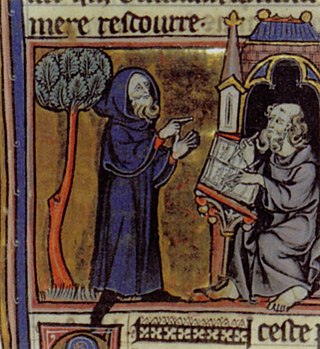
Merlin is a partly lost French epic poem written by Robert de Boron in Old French and dating from either the end of the 12th or beginning of the 13th century. The author reworked Geoffrey of Monmouth's material on the legendary Merlin, emphasising Merlin's power to prophesy and linking him to the Holy Grail. The poem tells of his origin and early life as a redeemed Antichrist, his role in the birth of Arthur, and how Arthur became King of Britain. Merlin's story relates to Robert's two other reputed Grail poems, Joseph d'Arimathie and Perceval. Its motifs became popular in medieval and later Arthuriana, notably the introduction of the sword in the stone, the redefinition of the Grail, and turning the previously peripheral Merlin into a key character in the legend of King Arthur.
The Tale of Ralph the Collier, also known as The Tale of Ralph Collier and The Taill of Rauf Coilyear, is a Scottish dialect Middle English poem composed in the late fifteenth century. It constituted a revival of Middle English alliterative verse, wherein the first and middle parts of each verse begin with the same sound.
The Christianisation of Anglo-Saxon England was a process spanning the 7th century. It was essentially the result of the Gregorian mission of 597, which was joined by the efforts of the Hiberno-Scottish mission from the 630s. From the 8th century, the Anglo-Saxon mission was, in turn, instrumental in the conversion of the population of the Frankish Empire.
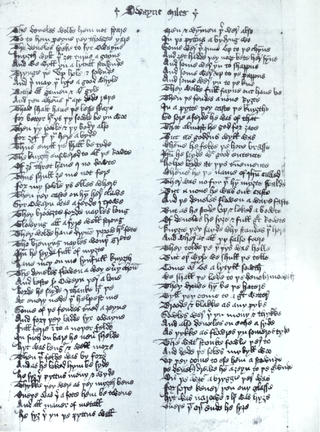
Octavian is a 14th-century Middle English verse translation and abridgement of a mid-13th century Old French romance of the same name. This Middle English version exists in three manuscript copies and in two separate compositions, one of which may have been written by the 14th-century poet Thomas Chestre who also composed Libeaus Desconus and Sir Launfal. The other two copies are not by Chestre and preserve a version of the poem in regular twelve-line tail rhyme stanzas, a verse structure that was popular in the 14th century in England. Both poetic compositions condense the Old French romance to about 1800 lines, a third of its original length, and relate “incidents and motifs common in legend, romance and chanson de geste.” The story describes a trauma that unfolds in the household of Octavian, later the Roman Emperor Augustus, whose own mother deceives him into sending his wife and his two newborn sons into exile and likely death. After many adventures, the family are at last reunited and the guilty mother is appropriately punished.

The Harley Lyrics is the usual name for a collection of lyrics in Middle English, Anglo Norman, and Latin found in Harley MS 2253, a manuscript dated ca. 1340 in the British Library's Harleian Collection. The lyrics contain "both religious and secular material, in prose and verse and in a wide variety of genres." The manuscript is written in three recognisable hands: scribe A, scribe B or the Ludlow scribe, and scribe C.

Beves of Hamtoun, also known as Beves of Hampton, Bevis of Hampton or Sir Beues of Hamtoun, is an anonymous Middle English romance of 4620 lines, dating from around the year 1300, which relates the adventures of the English hero Beves in his own country and in the Near East. It is often classified as a Matter of England romance. It is a paraphrase or loose translation of the Anglo-Norman romance Boeuve de Haumton, and belongs to a large family of romances in many languages, including Welsh, Russian and even Yiddish versions, all dealing with the same hero.
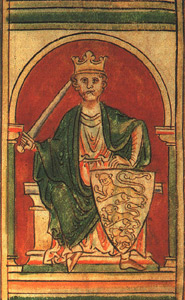
Richard Coer de Lyon is a Middle English romance which gives a fictionalised account of the life of Richard I, King of England, concentrating on his crusading exploits. It influenced Shakespeare's King John and Walter Scott's The Talisman.
Sir Tristrem is a 13th-century Middle English romance of 3,344 lines, preserved in the Auchinleck manuscript in the National Library of Scotland. Based on the Tristan of Thomas of Britain, it is the only surviving verse version of the Tristan legend in Middle English.
References
- 1 2 Laura A. Hibbard, Medieval Romance in England p45 New York Burt Franklin,1963
- 1 2 3 "The King of Tars: Introduction | Robbins Library Digital Projects" . Retrieved 2019-11-12.
- 1 2 3 "The King of Tars | Robbins Library Digital Projects".
- 1 2 3 4 5 "The King of Tars | Robbins Library Digital Projects" . Retrieved 2019-11-12.
- ↑ Chandler, John H., ed. (2015-09-01). The King of Tars. Medieval Institute Publications. doi:10.2307/j.ctvndv7sx. ISBN 9781580442381.
- ↑ Laura A. Hibbard, Medieval Romance in England p15 New York Burt Franklin,1963
- ↑ Carol Falvo Heffernan, Le Bone Florence of Rome, p 31-2 ISBN 0-7190-0647-3 OCLC 422642874
- ↑ Margaret Schlauch, Chaucer's Constance and Accused Queens, New York: Gordian Press 1969 p 125
- 1 2 "The King of Tars | Robbins Library Digital Projects". d.lib.rochester.edu. Retrieved 2019-11-12.
- 1 2 "The King of Tars Robbins Library Digital Projects". d.lib.rochester.edu. Retrieved 2019-11-16.
- ↑ "The King of Tars | Robbins Library Digital Projects". d.lib.rochester.edu. Retrieved 2019-11-16.
- ↑ Lomuto, Sierra (2019-07-03). "The Mongol Princess of Tars: Global Relations and Racial Formation in The King of Tars (c. 1330)". Exemplaria. 31 (3): 171–192. doi:10.1080/10412573.2019.1642608. ISSN 1041-2573. S2CID 204473780.
- 1 2 3 Calkin, Siobhain Bly (2005). "Marking Religion on the Body: Saracens, Categorization, and "The King of Tars"". The Journal of English and Germanic Philology. 104 (2): 219–238. ISSN 0363-6941. JSTOR 27712494.
- ↑ "The King of Tars: Introduction | Robbins Library Digital Projects".
- ↑ Heng, Geraldine (2003). Empire of Magic: Medieval Romance and the Politics of Cultural Fantasy. Columbia University Press. JSTOR 10.7312/heng12526.
- 1 2 3 4 5 Calkin, Siobhain Bly (2005). "Marking Religion on the Body: Saracens, Categorization, and "The King of Tars"". The Journal of English and Germanic Philology. 104 (2): 219–238. ISSN 0363-6941. JSTOR 27712494.
- ↑ Gilchrist, John (1988). "The Papacy and War against the 'Saracens', 795-1216". The International History Review. 10 (2): 174–197. ISSN 0707-5332. JSTOR 40105866.
- ↑ Hornstein, Lilian Herlands (October 1941). "The Historical Background of the King of Tars". Speculum. 16 (4): 404–414. doi:10.2307/2852840. ISSN 0038-7134. JSTOR 2852840.
- ↑ "The King of Tars | Robbins Library Digital Projects". d.lib.rochester.edu. Retrieved 2019-11-19.
- ↑ Whitaker, Cord J. (2013). "Black Metaphors in the King of Tars". The Journal of English and Germanic Philology. 112 (2): 169–193. doi:10.5406/jenglgermphil.112.2.0169. ISSN 0363-6941. JSTOR 10.5406/jenglgermphil.112.2.0169. S2CID 162538984.
- ↑ Head, Thomas (1999). "Women and Hagiography in Medieval Christianity" (PDF). Online Reference Book for Medieval Studies.
- 1 2 Lomuto, Sierra (2019-07-03). "The Mongol Princess of Tars: Global Relations and Racial Formation in The King of Tars (c. 1330)". Exemplaria. 31 (3): 171–192. doi:10.1080/10412573.2019.1642608. ISSN 1041-2573. S2CID 204473780.
- ↑ "The King of Tars | Robbins Library Digital Projects". d.lib.rochester.edu. Retrieved 2019-11-18.
- ↑ "The King of Tars: Introduction | Robbins Library Digital Projects" . Retrieved 2017-12-07.
- ↑ "The King of Tars: Introduction | Robbins Library Digital Projects". d.lib.rochester.edu. Retrieved 2019-11-15.
- ↑ "The King of Tars: Introduction | Robbins Library Digital Projects". d.lib.rochester.edu. Retrieved 2019-11-18.